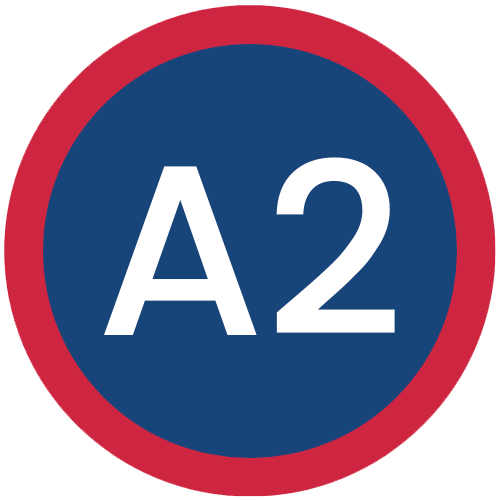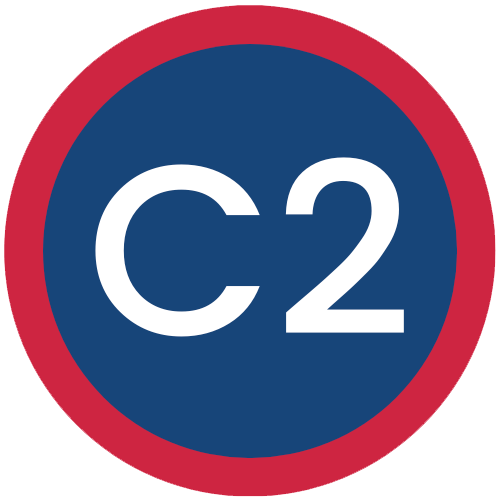
What Is Your English Level?

NOVICE HIGH LEVEL – A1
Speakers at the Novice High Sublevel are able to handle a variety of tasks pertaining to the intermediate level but are unable to sustain performance at that level. They are able to manage successfully a number of uncomplicated communicative tasks in straightforward social situations. Conversation is restricted to a few of the predictable topics necessary for survival in the target language culture such as basic personal information, basic objects, and a limited number of activities, preferences, and immediate needs. Novice High speakers respond to simple, direct questions or requests for information. They are also able to ask a few formulaic questions.
Novice High Writers at the Novice High Sublevel are able to meet limited basic practical writing needs using lists, short messages, postcards, and simple notes. They are able to express themselves within the context in which the language was learned, relying mainly on practiced material. Their writing is focused on common elements of daily life. Novice High writers are able to recombine learned vocabulary and structures to create simple sentences on very familiar topics but are not able to sustain sentence-level writing all the time. Due to inadequate vocabulary and/or grammar, writing at this level may only partially communicate the intentions of the writer. Novice High writing is often comprehensible to natives used to the writing of non-natives, but gaps in comprehension may occur.
INTERMEDIATE LOW – A2
Intermediate Low Speakers at the Intermediate Low Sublevel are able to handle successfully a limited number of uncomplicated, communicative tasks by creating with the language in straightforward social situations. Conversation is restricted to some of the concrete exchanges and predictable topics necessary for survival in the target-language culture. These topics relate to basic personal information; for example, self and family, some daily activities and personal preferences, and some immediate needs, such as ordering food and making simple purchases. At the Intermediate Low Sublevel, speakers are primarily reactive and struggle to answer direct questions or requests for information. They are also able to ask a few appropriate questions. Intermediate Low speakers manage to sustain the functions of the Intermediate level, although just barely. Intermediate Low speakers express personal meaning by combining and recombining what they know and what they hear from their interlocutors into short statements and discrete sentences. Their responses are often filled with hesitancy and inaccuracies as they search for appropriate linguistic forms and vocabulary while attempting to give form to the message. Their speech is characterized by frequent pauses, ineffective reformulations and self-corrections. Their pronunciation, vocabulary, and syntax are strongly influenced by their first language. In spite of frequent misunderstandings that may require repetition or rephrasing, Intermediate Low Speakers can generally be understood by sympathetic interlocutors, particularly by those accustomed to dealing with non-natives, but there are likely to be gaps in comprehension.
Intermediate Low Writers at the Intermediate Low Sublevel are able to meet some limited practical writing needs. They can create statements and formulate questions based on familiar material. Most sentences are re-combinations of learned vocabulary and structures. These are short and simple conversational-style sentences with basic word order. They are written almost exclusively in present time. Writing tends to consist of a few simple sentences, often with repetitive structure. Topics are tied to highly predictable content areas and personal information. Vocabulary is adequate to express elementary needs. There may be basic errors in grammar, word choice, punctuation, spelling, and in the formation and use of non-alphabetic symbols. Their writing is understood by natives used to the writing of non-natives, although additional effort may be required. When Intermediate Low Writers attempt to perform writing tasks at the Advanced Level, their writing will deteriorate significantly, and their message may be left incomplete.


INTERMEDIATE HIGH – B1
Intermediate High Speakers are able to converse with ease and confidence when dealing with the routine tasks and social situations of the Intermediate Level. They are able to handle successfully uncomplicated tasks and social situations requiring an exchange of basic information related to their work, school, recreation, particular interests, and areas of competence. Intermediate High Speakers can handle a substantial number of tasks associated with the Advanced Level, but they are unable to sustain performance of all of these tasks all of the time. Intermediate High Speakers can narrate and describe in all major time frames using connected discourse of paragraph length, but not all the time. Typically, when Intermediate High Speakers attempt to perform Advanced-Level tasks, their speech exhibits one or more features of breakdown, such as the failure to carry out fully the narration or description in the appropriate major time frame, an inability to maintain paragraph-length discourse, or a reduction in breadth and appropriateness of vocabulary. Intermediate High Speakers can generally be understood by native speakers unaccustomed to dealing with non-natives, although interference from another language may be evident (e.g., use of code-switching, false cognates, literal translations), and a pattern of gaps in communication may occur.
Intermediate High Writers at the Intermediate High Sublevel are able to meet all practical writing needs of the Intermediate level. Additionally, they can write compositions and simple summaries related to work and/or school experiences. They can narrate and describe in different time frames when writing about everyday events and situations. These narrations and descriptions are often but not always of paragraph length, and they typically contain some evidence of breakdown in one or more features of the Advanced Level. For example, these writers may be inconsistent in the use of appropriate major time markers, resulting in a loss of clarity. The vocabulary, grammar, and style of Intermediate High Writers essentially correspond to those of the spoken language. Intermediate High Writing, even with numerous and perhaps significant errors, is generally comprehensible to natives not used to the writing of non-natives, although additional effort may be required. When Intermediate Low Writers attempt to perform writing tasks at the Advanced level, their writing will deteriorate significantly and their message may be left incomplete.
ADVANCED LOW LEVEL – B2
Advanced Low Speakers at the Advanced Low Sublevel are able to handle a variety of communicative tasks. They are able to participate in most informal and some formal conversations on topics related to school, home, and leisure activities. They can also speak about some topics related to employment, current events, and matters of public and community interest. Advanced Low Speakers demonstrate the ability to narrate and describe in the major time frames of past, present, and future in paragraph-length discourse with some control of aspect. In these narrations and descriptions, Advanced Low Speakers combine and link sentences into connected discourse of paragraph length, although these narrations and descriptions tend to be handled separately rather than interwoven. They can handle appropriately the essential linguistic challenges presented by a complication or an unexpected turn of events. Responses produced by Advanced Low Speakers are typically not longer than a single paragraph. The speaker’s dominant language may be evident in the use of false cognates, literal translations, or the oral paragraph structure of that language. At times, their discourse may be minimal for the level, marked by an irregular flow, and containing noticeable self-correction. More generally, the performance of Advanced Low Speakers tends to be uneven. Advanced Low speech is typically marked by a certain grammatical roughness (e.g., inconsistent control of verb endings), but the overall performance of the Advanced-Level tasks is sustained, albeit minimally. The vocabulary of Advanced Low Speakers often lacks specificity. Nevertheless, Advanced Low Speakers are able to use communicative strategies such as rephrasing and circumlocution. Advanced Low Speakers contribute to the conversation with sufficient accuracy, clarity, and precision to convey their intended message without misrepresentation or confusion. Their speech can be understood by native speakers unaccustomed to dealing with non-natives, even though this may require some repetition or restatement. When attempting to perform functions or handle topics associated with the Superior Level, the linguistic quality and quantity of their speech will deteriorate significantly.
Advanced Low Writers at the Advanced Low Sublevel are able to meet basic work and/or academic writing needs. They demonstrate the ability to narrate and describe in major time frames with some control of aspect. They are able to compose simple summaries on familiar topics. Advanced Low Writers are able to combine and link sentences into texts of paragraph length and structure. Their writing, while adequate to satisfy the criteria of the Advanced Level, may not be substantive. Writers at the Advanced Low Sublevel demonstrate the ability to incorporate a limited number of cohesive devices, and may resort to some redundancy and awkward repetition. They rely on patterns of oral discourse and the writing style of their first language. These writers demonstrate minimal control of common structures and vocabulary associated with the Advanced Level. Their writing is understood by natives not accustomed to the writing of non-natives, although some additional effort may be required in the reading of the text. When attempting to perform functions at the Superior Level, their writing will deteriorate significantly.


ADVANCED HIGH – C1
Advanced High Speakers at the Advanced High Sublevel perform all Advanced-Level tasks with linguistic ease, confidence, and competence. They are consistently able to explain in detail and narrate fully and accurately in all time frames. In addition, Advanced High Speakers handle the tasks pertaining to the Superior Level but cannot sustain performance at that level across a variety of topics. They may provide a structured argument to support their opinions, and they may construct hypotheseSs, but patterns of error appear. They can discuss some topics abstractly, especially those relating to their particular interests and special fields of expertise, but in general, they are more comfortable discussing a variety of topics concretely. Advanced High Speakers may demonstrate a well-developed ability to compensate for an imperfect grasp of some forms or for limitations in vocabulary by the confident use of communicative strategies, such as paraphrasing, circumlocution, and illustration. They use precise vocabulary and intonation to express meaning and often show great fluency and ease of speech. However, when called on to perform the complex tasks associated with the Superior Level over a variety of topics, their language will at times break down or prove inadequate, or they may avoid the task altogether, for example, by resorting to simplification through the use of description or narration in place of argument or hypothesis.
Advanced High Writers at the Advanced High Sublevel are able to write about a variety of topics with significant precision and detail. They can handle informal and formal correspondence according to appropriate conventions. They can write summaries and reports of a factual nature. They can also write extensively about topics relating to particular interests and special areas of competence, although their writing tends to emphasize the concrete aspects of such topics. Advanced High Writers can narrate and describe in the major time frames, with solid control of aspect. In addition, they are able to demonstrate the ability to handle writing tasks associated with the Superior Level, such as developing arguments and constructing hypotheses, but are not able to do this all of the time; they cannot produce Superior-Level Writing consistently across a variety of topics treated abstractly or generally. They have good control of a range of grammatical structures and a fairly wide general vocabulary. When writing at the Advanced Level, they often show remarkable ease of expression, but under the demands of Superior-Level writing tasks, patterns of error appear. The linguistic limitations of Advanced High Writing may occasionally distract the native reader from the message.
SUPERIOR LEVEL – C2
Speakers at the Superior Level are able to communicate with accuracy and fluency in order to participate fully and effectively in conversations on a variety of topics in formal and informal settings from both concrete and abstract perspectives. They discuss their interests and special fields of competence, explain complex matters in detail, and provide lengthy and coherent narrations, all with ease, fluency, and accuracy. They present their opinions on a number of issues of interest to them, such as social and political issues, and provide structured arguments to support these opinions. They are able to construct and develop hypotheses to explore alternative possibilities. When appropriate, these speakers use extended discourse without unnaturally lengthy hesitation to make their point, even when engaged in abstract elaborations. Such discourse, while coherent, may still be influenced by language patterns other than those of the target language. Superior-Level Speakers employ a variety of interactive and discourse strategies, such as turn-taking and se parating main ideas from supporting information through the use of syntactic, lexical, and phonetic devices. Speakers at the Superior Level demonstrate no pattern of error in the use of basic structures, although they may make sporadic errors, particularly in low-frequency structures and in complex high-frequency structures. Such errors, if they do occur, do not distract the native interlocutor or interfere with communication.
Writers at the Superior Level are able to produce most kinds of formal and informal correspondence, in-depth summaries, reports, and research papers on a variety of social, academic, and professional topics. Their treatment of these issues moves beyond the concrete to the abstract. Writers at the Superior Level demonstrate the ability to explain complex matters, and to present and support opinions by developing cogent arguments and hypotheses. Their treatment of the topic is enhanced by the effective use of structure, lexicon, and writing protocols. They organize and prioritize ideas to convey to the reader what is significant. The relationship among ideas is consistently clear, due to organizational and developmental principles (e.g., cause and effect, comparison, chronology). These writers are capable of extended treatment of a topic which typically requires at least a series of paragraphs but can extend to a number of pages. Writers at the Superior Level demonstrate a high degree of control of grammar and syntax, of both general and specialized/professional vocabulary, of spelling or symbol production, of cohesive devices, and of punctuation. Their vocabulary is precise and varied. Writers at this level direct their writing to their audiences; their writing fluency eases the reader’s task. Writers at the Superior Level do not typically control target-language cultural, organizational, or stylistic patterns. At the Superior Level, writers demonstrate no pattern of error; however, occasional errors may occur, particularly in low-frequency structures. When present, these errors do not interfere with comprehension, and they rarely distract the native reader.

